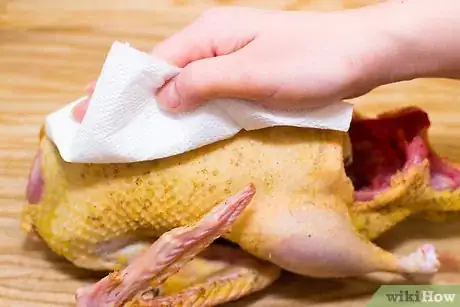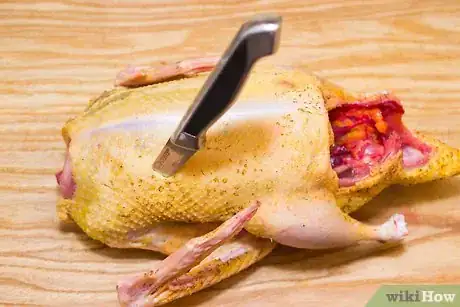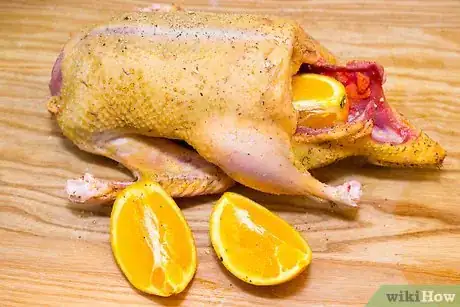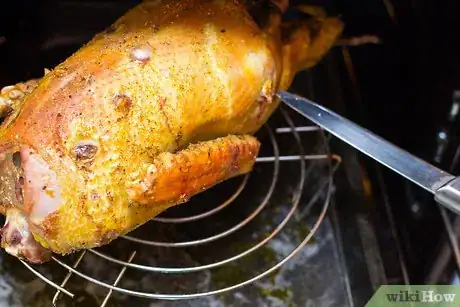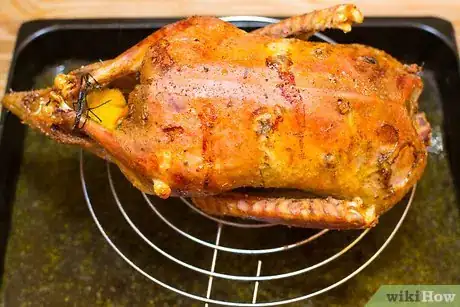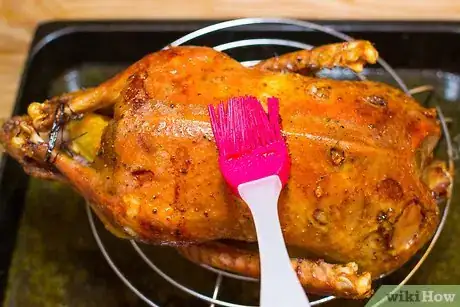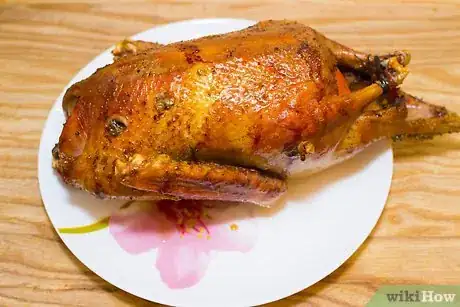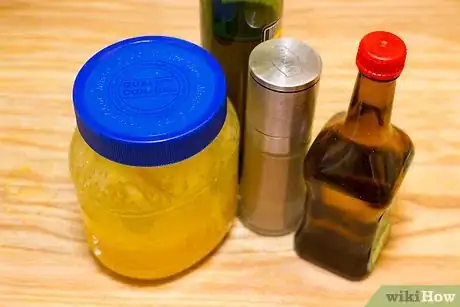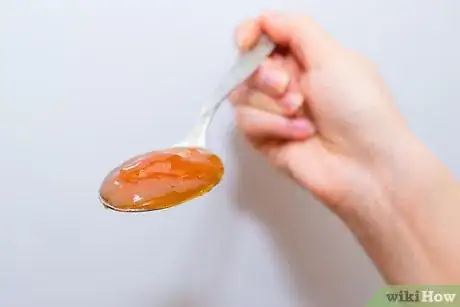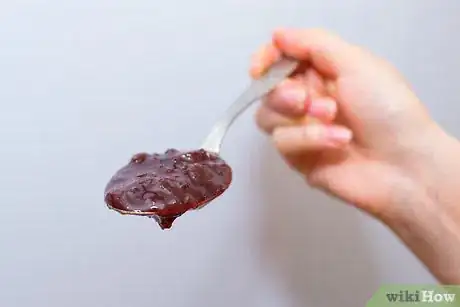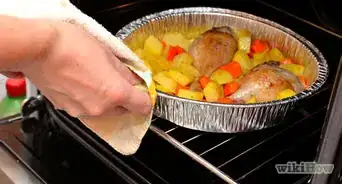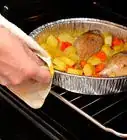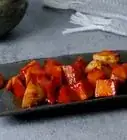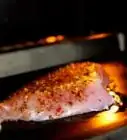wikiHow is a “wiki,” similar to Wikipedia, which means that many of our articles are co-written by multiple authors. To create this article, 16 people, some anonymous, worked to edit and improve it over time.
This article has been viewed 43,992 times.
Learn more...
People around the world enjoy the distinct flavor of duck, which is a dark meat. Some of the most popular duck recipes are Peking Duck, a Chinese dish, and Duck a l' Orange, a French dish. Roasting is one of the most popular methods of enjoying this bird. When prepared properly, roast duck is crisp outside with moist and flavorful meat inside. To learn how to perfectly roast a duck, start with Step 1 below.
Steps
Preparing the Duck
-
1Choose a 5/6 lbs duck. To prepare a roast duck dish that will serve 2 people, you will need to buy a 5/6 lbs duck. The most common varieties are Pekin or Long Island ducks, which have a pleasantly mild flavor. Muscovy ducks have a stronger, more gamy flavor.[1]
-
2Remove the giblets. Remove the duck from its packaging, then remove the giblets from the cavity. You can do with these as you please: some people just throw them away, while others reserve the liver for making duck liver pâté and use the other giblets to make stock.
-
3Clean the bird. Once the giblets have been removed, wash the duck in cold running water. Shake it out to remove any water from the cavity, then pat the duck with paper towels until the ski is very dry. Place the dried duck on a wire rack over a deep roasting pan lined with paper foil.
-
4Score the fat. Take a small, sharp paring knife and use it to score a crosshatch (diamond) pattern on the suck breast.
- Be very careful -- you only want to score the fat, not the meat underneath. This is easier if you hold the knife at an angle.
- Next, prick the duck all over with the point of the knife -- again, you only want to prick the skin, not the meat underneath. Doing this will allow more fat to escape from the skin and will produce a crispier roasted duck.[2]
- Now, use the knife to remove any excess skin on either side of the cavity. You can discard this skin, or simmer it in water to remove the fat.
-
5Season and truss the duck. Season the inside and outside of the duck with coarse salt and freshly ground black pepper. Truss the legs by crossing them and tying them with a piece of butcher's twine.
- Before you truss the legs, you can fill the cavity with a quartered onion or a quartered orange -- this helps to keep the duck moist and adds moisture.
- Cut off the tips of the wings at the final joint, then tuck the wings underneath the duck (just as you would when roasting a chicken).
Roasting the Duck
-
1Roast the duck at 300 °F (149 °C) for one hour. Place the duck on the second lowest rack of the oven, which should be pre-heated to 300 °F (149 °C). Roast, breast-side up, for one hour.
-
2Prick the skin and flip the duck over. After the first hour of roasting, pull the roasting tin from the oven and prick the duck's skin with a sharp knife to release the melted fat.
- Pay particular attention to the areas around the legs, as these are particularly fatty.
- Flip the duck over so it's breast-side down, return it to the oven and roast for another hour.
-
3Repeat this process for the next two hours. After the second hour, remove the duck from the oven, prick it all over to release the fat, then turn it breast-side up and return it to the oven for another hour.
- After the third hour, prick the fat and turn the duck breast-side down and return to the oven for the final hour of roasting.
- The duck should be getting progressively browner and crispier as time goes on.
-
4Remove the fat and finish roasting. After the fourth hour of roasting, remove the duck from the oven. Turn the oven temperature up to 400 °F (204 °C) and wait for it to pre-heat.
- While you're waiting, spoon the duck fat from the bottom of the roasting tin. Be very careful doing this, as the fat is extremely hot and could cause a nasty burn.
- Once cooled, the duck fat will keep for several months in the fridge. It can be used to make delicious roast potatoes and veggies, or even to add flavor to a roast chicken!
- Once the oven reaches 400 °F (204 °C), place the duck back in the oven, breast-side up and roast for 10 more minutes. This will help the skin to get really crisp.
-
5Add the glaze (optional). After ten minutes, remove the duck from the oven. If you are using a glaze (like one of the ones described below), brush it liberally over the skin of the duck.
- Then return the bird to the oven to cook for another 5 to 7 minutes at 400 °F (204 °C), until it is dark brown in color. Watch the duck carefully during this time, as you don't want it to burn!
- Instead of using a glaze, you can simply serve the roasted duck with a sauce on the side (recipes can be found below). If you go for this option, there's no need to return the duck to the oven for these final 5 to 7 minutes.
-
6Let it rest. Once you've removed the duck from the oven, allow it to rest on the wire rack for 10 minutes. Carve the duck just like you'd carve a roast chicken and serve.[3]
Making Sauces and Glazes
-
1Make a sweet and spicy glaze. To make this sweet and spicy glaze you will need:
- 1/4 cup of honey
- 1/4 cup of molasses
- 3 tablespoons of orange juice
- 1 tablespoon of soy sauce
- 1 1/2 tablespoons of sriracha
- Combine all of the ingredients in a saucepan and bring to a simmer over a low heat. Raise the temperature to a medium-high heat and whisk the mixture constantly until it thickens enough to coat the back of a spoon.
- Set the glaze aside until you are ready to use on the duck. If it becomes too thick, heat it up in the microwave before using.
-
2Make an orange and sage glaze. To make this citrus-y, herb-y glaze you will need:
- 3/4 cup of fresh orange juice
- 2 tablespoons of freshly chopped sage
- 1/2 cup + 1 tablespoon of orange marmalade
- 1 1/2 tablespoons of brandy
- Add the orange juice and sage to a saucepan and boil over a high heat until approximate 1/4 cup of liquid remains. Reduce the heat, add the remaining ingredients and simmer until the glaze becomes thick and bubbly.
- Set the glaze aside until ready to use.
-
3Make a balsamic vinegar and honey glaze. To make this tart glaze you will need:
- 10 tablespoons + 2 teaspoons of balsamic vinegar
- 1/4 cup of honey
- 1/2 teaspoon freshly ground black pepper
- 1/2 teaspoon red wine vinegar
- Add the 10 tablespoons of balsamic vinegar, honey and pepper to a saucepan and boil over a high heat until the mixture thickens. Stir constantly until the glaze is reduced to 3 tablespoons of liquid.
- Remove from the heat, then add the 2 teaspoons of balsamic and 1/2 teaspoon of red wine vinegar. Keep the glaze warm until ready to use on the duck.
-
4Make a plum and applesauce. To make this delicious red applesauce, you will need:
- 2 lbs red apples, quartered and seeded
- 2lbs red or black plums, quartered and pitted
- 1/4 cup of water
- 1/4 cup of sugar
- Place all of the ingredients in a heavy-bottomed saucepan (with a lid) and cook over a medium heat for an hour and 15 minutes, stirring occasionally, until the fruit is very soft and tender.
- Push the fruit through a fine-meshed strainer to remove the fruit skins. Serve the sauce alongside the roasted duck (or enjoy on its own as dessert!)[4]
-
5Make a lemon and redcurrant sauce. This is a simple yet tasty sauce for when you need to throw something together in a hurry.
- All you need to do is mix 1 cup of redcurrant jelly with 1 tablespoon of lemon juice in a small saucepan.
- Bring the sauce to the boil, then push through a fine-meshed strainer and serve with the roasted duck.
Community Q&A
-
QuestionHow many people will a 5-pound duck feed?
 Community AnswerA five-pound duck will feed approximately about 9 or 10 people.
Community AnswerA five-pound duck will feed approximately about 9 or 10 people. -
QuestionShould I fill the cavity with stuffing?
 AnnieCommunity AnswerYou can. A lot of recipes include stuffing poultry, although it is not necessary. Cook it how you like - when you cook yourself, your imagination is the limit.
AnnieCommunity AnswerYou can. A lot of recipes include stuffing poultry, although it is not necessary. Cook it how you like - when you cook yourself, your imagination is the limit.
Warnings
- Stuffing any type of raw bird can be hazardous because the stuffing may mix with raw juices containing bacteria. The stuffing inside a bird might not reach a sufficient temperature to kill the bacteria. Thus many cooks choose to cook stuffing outside a bird. Even cooks who choose to stuff birds don't stuff ducks because it absorbs too much fat while the duck roasts, rendering it inedible.⧼thumbs_response⧽
References
About This Article
Before roasting a duck, preheat the oven to 300 degrees Fahrenheit while you remove the giblets and use a sharp paring knife to score the fat. Then, place the duck on the second lowest rack in the oven, breast-side up, for 1 hour. After 1 hour, flip the duck over, prick it to release the fat, and roast it for another hour. Repeat this process 4 times, then turn the oven up to 400 degrees. Roast the duck for 10 more minutes at this higher temperature to crisp the skin. For tips on how to add a glaze, keep reading!


